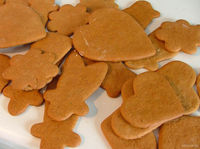
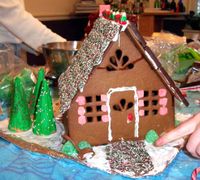
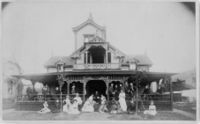
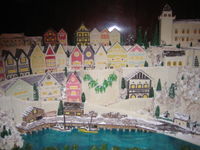
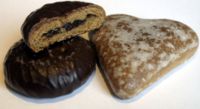
Gingerbread is a sweet that can take the form of a cake or a cookie in which the predominant flavor is ginger.
As a cookie, gingerbread can be made into a thin, crisp cookie (often called a ginger snap) or a softer cookie similar to the German Lebkuchen. Gingerbread cookies are often cut into shapes, particularly gingerbread men.
A variant dough is used to make gingerbread houses à la the "witch's house" encountered by Hansel and Gretel. These, covered with a variety of candies and icing, are a common Christmas decoration.
Another variant uses a boiled dough that can be molded like clay to form inedible statuettes or other decorations. A significant form of popular art in Europe, major centers of gingerbread mould carving included Lyon, Nürnberg, Pest, Prague, Pardubice, Ulm, and Toruń (ger.: Thorner Kathrinchen). Gingerbread moulds often displayed the "news", showing carved portraits of new kings, emperors, and queens, for example. Substantial mould collections are held at the Ethnographic Museum in Toruń, Poland and the Bread Museum in Ulm, Germany.
The cake form tends to be a dense, treaclely (molasses-based) spice cake. Some recipes add mustard, pepper, raisins, nuts, and/or other spices/ingredients to the batter. In the U.S. state of Vermont gingerbread cake rarely includes raisins or nuts. The Vermont style of cake is flavored with powdered ginger and ground black pepper for intensity. Rather than being iced or frosted, the cake is served with warm lemon sauce. Until recent years it was a common Vermont 4th of July dessert, but today is more often served in the winter, particularly at Christmastime.
Originally, the term gingerbread (from Latin zingiber via Old French gingebras) referred to preserved ginger, then to a confection made with honey and spices.
Gingerbread is often translated into French as pain d'épices. Pain d'épices is a French pastry also made with honey and spices, but not crispy.
Gingerbread is also an architectural term for highly decorated Victorian houses.
External links
- Godecookery.com recipes
- Historical gingerbread recipes
- Nürnberg Gingerbread history and folklore
Categories: Christmas food
